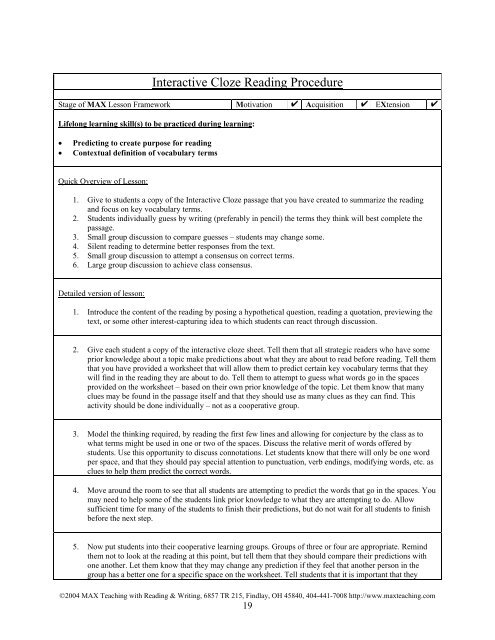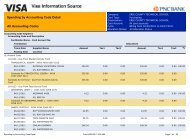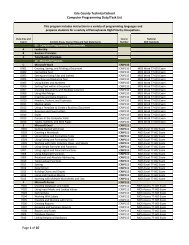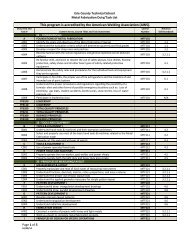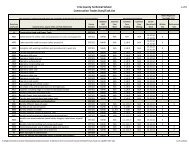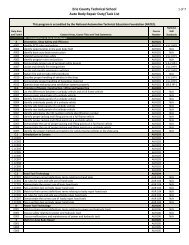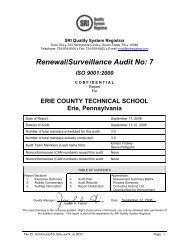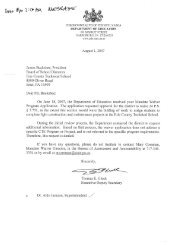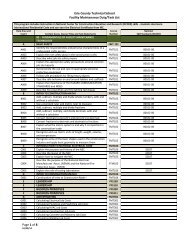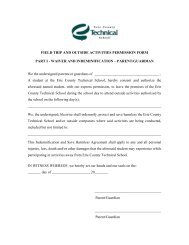Students should, before even entering the cooperative group, have something in writing towhich they have committed. This gives each student a stake in the process – an idea that can bediscussed or defended even before the learning experience.Once students have gathered information from the reading (or video, lecture, etc.), theirdiscussions will be enhanced by an attempt to come to a consensus on their interpretation of thelearning material. Consensus means each of the students in a cooperative learning group mustagree on an interpretation, <strong>and</strong> this should be attempted first in small groups <strong>and</strong> then as a class.The process of attempting to achieve consensus assures that all students are involved in the coreprocess of reading – construction of meaning. The result is that all participants acquire readingskills <strong>with</strong>out even being aware that they are doing so.How Frequently Should Teachers Use <strong>MAX</strong>?All effective teachers use some form of the three steps that comprise <strong>MAX</strong>. At thebeginning of class, most teachers use some form of an “anticipatory set” to get students thinkingabout the subject matter. The new information is often then “presented” in some format such as alecture, video, teacher-led discussion, or some other way of communicating information. Thepresentation of new information is usually followed by some form of check, such as a worksheetor quiz.Thus, the paradigm shift in using <strong>MAX</strong> as a framework of instruction is easy for mostteachers since, <strong>with</strong> <strong>MAX</strong>, they now become facilitators of their students’ active learningthrough the use of reading, writing, speaking, listening, <strong>and</strong> thinking in the middle <strong>and</strong> finalphases of class. The teacher acts as a “master learner” among “apprentice learners” in aclassroom wherein the focus is on acquisition of knowledge <strong>and</strong> skills through guided practice inusing literacy skills to process new subject matter.Using literacy skills to process new underst<strong>and</strong>ings can easily become the central focusof a classroom <strong>and</strong> can be used as a way to learn any new information. The variety of testedstrategies available to teachers is enormous. Researched <strong>and</strong> proven strategies abound. Thus,practicing literacy skills to learn should not be a once-a-week or once-a-month activity. It canbecome the routine of a classroom in which students are engaged in making personal meaningfrom text <strong>and</strong> discussion every day.Which Teachers Should Teach This Way?Teachers who use the <strong>MAX</strong> teaching framework do not need to be reading specialists.Academic <strong>and</strong> vocational teachers from the elementary grades through high school only need torecognize that by using the concrete tools of text <strong>and</strong> student writing, along <strong>with</strong> teachermodeling <strong>and</strong> cooperative learning, they can help their students routinely achieve higher orderthinking about their subject matter. Staff development in using these strategies is accomplishedthrough h<strong>and</strong>s-on demonstration <strong>and</strong> modeling. Any teacher can use these techniques. Afterparticipating in staff development in using reading <strong>and</strong> writing to learn, most teachers areimmediately able to employ a variety of reading/writing strategies in their classrooms. Recentresearch has demonstrated that students can improve their reading levels by two or more yearsover a six month time period when exposed to learning through these strategies (Greenleaf,Schoenbach, Cziko, & Mueller, 2001). Which teachers would not want to teach this way?©2004 <strong>MAX</strong> <strong>Teaching</strong> <strong>with</strong> <strong>Reading</strong> & <strong>Writing</strong>, 6857 TR 215, Findlay, OH 45840, 404-441-7008 http://www.maxteaching.com18
Interactive Cloze <strong>Reading</strong> ProcedureStage of <strong>MAX</strong> Lesson Framework Motivation ƒ Acquisition ƒ EXtension ƒLifelong learning skill(s) to be practiced during learning:• Predicting to create purpose for reading• Contextual definition of vocabulary termsQuick Overview of Lesson:1. Give to students a copy of the Interactive Cloze passage that you have created to summarize the reading<strong>and</strong> focus on key vocabulary terms.2. Students individually guess by writing (preferably in pencil) the terms they think will best complete thepassage.3. Small group discussion to compare guesses – students may change some.4. Silent reading to determine better responses from the text.5. Small group discussion to attempt a consensus on correct terms.6. Large group discussion to achieve class consensus.Detailed version of lesson:1. Introduce the content of the reading by posing a hypothetical question, reading a quotation, previewing thetext, or some other interest-capturing idea to which students can react through discussion.2. Give each student a copy of the interactive cloze sheet. Tell them that all strategic readers who have someprior knowledge about a topic make predictions about what they are about to read before reading. Tell themthat you have provided a worksheet that will allow them to predict certain key vocabulary terms that theywill find in the reading they are about to do. Tell them to attempt to guess what words go in the spacesprovided on the worksheet – based on their own prior knowledge of the topic. Let them know that manyclues may be found in the passage itself <strong>and</strong> that they should use as many clues as they can find. Thisactivity should be done individually – not as a cooperative group.3. Model the thinking required, by reading the first few lines <strong>and</strong> allowing for conjecture by the class as towhat terms might be used in one or two of the spaces. Discuss the relative merit of words offered bystudents. Use this opportunity to discuss connotations. Let students know that there will only be one wordper space, <strong>and</strong> that they should pay special attention to punctuation, verb endings, modifying words, etc. asclues to help them predict the correct words.4. Move around the room to see that all students are attempting to predict the words that go in the spaces. Youmay need to help some of the students link prior knowledge to what they are attempting to do. Allowsufficient time for many of the students to finish their predictions, but do not wait for all students to finishbefore the next step.5. Now put students into their cooperative learning groups. Groups of three or four are appropriate. Remindthem not to look at the reading at this point, but tell them that they should compare their predictions <strong>with</strong>one another. Let them know that they may change any prediction if they feel that another person in thegroup has a better one for a specific space on the worksheet. Tell students that it is important that they©2004 <strong>MAX</strong> <strong>Teaching</strong> <strong>with</strong> <strong>Reading</strong> & <strong>Writing</strong>, 6857 TR 215, Findlay, OH 45840, 404-441-7008 http://www.maxteaching.com19


